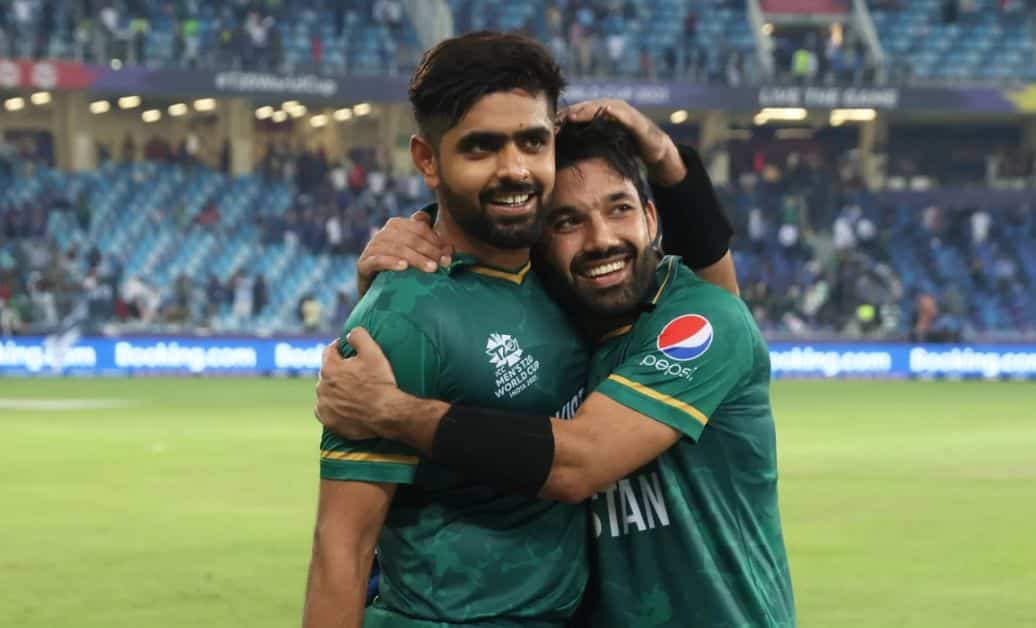As most Pakistanis wake up to the news of their team’s exit from the World Cup, they might seek some solace in the ICC Men’s T20I player rankings, where Babar Azam and Mohammad Rizwan still hold the 3rd and 4th spots, respectively. Babar has just reached the milestone of 4,000 runs in T20Is, and Rizwan has probably added a few more irrelevant records to his name during this World Cup. After all, who cares about making it to the Super 8s when you have bigger milestones to celebrate?
Babar Azam and Mohammad Rizwan, critical to Pakistan’s top order, have raised concerns with their performances, especially when batting first.
Their Runs Above Average Replacement (RAAR) figures—Babar at -315 and Rizwan at -82—highlight significant struggles. Even while chasing, their RAAR values are not impressive, with Babar slightly positive at 16 and Rizwan still negative at -57.
Additionally, their strike rates in the powerplay have been among the lowest in the last three T20 World Cups. Babar’s strike rate is a mere 89.2, the lowest for an opener, while Rizwan is at 99.16, just ahead of M Van Lingen’s 96.4.
Despite these dismal statistics, their occasional spectacular performances, such as the one in 2021 against India where they chased down 152 without losing a wicket, have often overshadowed their overall inefficiency. This singular feat has led many to overlook how frequently they have underperformed, often costing Pakistan crucial matches.
In the previous World Cup, their sluggish starts were evident in games against Bangladesh and Zimbabwe, where they put the middle order under immense pressure. But, Pakistan reached the final, and their performances were swept under the rug.
Pakistan’s biggest problem has been a failure to learn from past mistakes. The decision to drop Saim Ayub just before this World Cup and to bring back a tried and tested pair was a baffling move that ignored the lessons from the past and favoured familiarity over potential.
The Riz-Bar partnership has been a critical factor in Pakistan’s repeated exits. Whether it’s their inability to capitalize on powerplay overs or their lacklustre strike rates, their performance has left a lot to be desired.
Yet, it’s also crucial to acknowledge that their shortcomings are amplified because the rest of the batting lineup has failed to step up. When the middle order crumbles and the tail fails to wag, the focus inevitably shifts back to the openers, highlighting their inability to provide a solid start. This isn’t merely a one-off observation but a pattern that has been painfully evident in several key tournaments.
The most disappointing aspect is that Pakistan has been defeated at its own game. Traditionally, low-scoring, bowling-dominant matches have been Pakistan’s stronghold, where the team has excelled, clinching improbable victories through disciplined bowling and eventual chases. However, under Babar’s captaincy, it seems the very DNA of Pakistani cricket has mutated.
The team has forgotten how to win in conditions that should be tailor-made for them. On the US pitches where the average run rate hovers around 5.95, ideal for the cautious approach of Babar and Rizwan, their failure to create impact is alarming. This World Cup, with its favourable conditions, should have been their proving ground. If their opening partnership couldn’t succeed here, it’s hard to imagine it working anywhere else.
Recent outings, with opening stands of 9 and 26 in this World Cup, have starkly exposed their inefficacies, a critique that could be extended to the entire batting lineup. Their approach, effective in bilateral series and less crucial games, has failed to deliver on the biggest stages.
The team needs a shakeup, a new strategy that moves away from relying solely on the opening pair to take it deep. It’s time for Pakistan to rediscover its winning formula, starting with a more dynamic and aggressive approach at the top, one that can withstand the pressures of tournament cricket and deliver consistently, regardless of the conditions.
With Pakistan eliminated from the World Cup and failing to make it to the Super 8s, questions and blame are inevitable. First in line will be the star opening partnership, which has disappointed yet again. “Evolve or get left behind,” as Gary Kirsten said after the loss to India.
Sadly, these players, once considered the backbone of the team, are now past their peak. Babar Azam and Mohammad Rizwan, part of a lineup in continuous decline, have led to a seven-year trophy drought. Despite being given four T20I tournaments in four years, they have nothing to show for it and their decline is evident in their individual performances as well as the team’s overall output. A washed-up bunch of players, eliminated by a washout— poetic end to a story of unfulfilled promise.
(note: Expected Runs were calculated by Zain @zainalysis by utilizing a deep neural network model, taking into account ball-by-ball records for all T20 and T20I matches since 2015. This recalculation relies on four key factors: the innings run rate before the ball, the number of wickets lost before the ball, the number of balls remaining before the ball, and the number of balls faced by the batter in the innings before the ball. Over approximately 1.7 million deliveries in the dataset were processed and tested through a deep neural network model to derive expected runs for each ball, which were subsequently compared with the actual runs scored on the same ball, resulting in runs above average. This will help us in checking which player played better in the same context of the match and which was below an average batter.)
The post Stats Prove Babar and Rizwan are Way Behind the Curve in T20 Cricket appeared first on ProPakistani.



